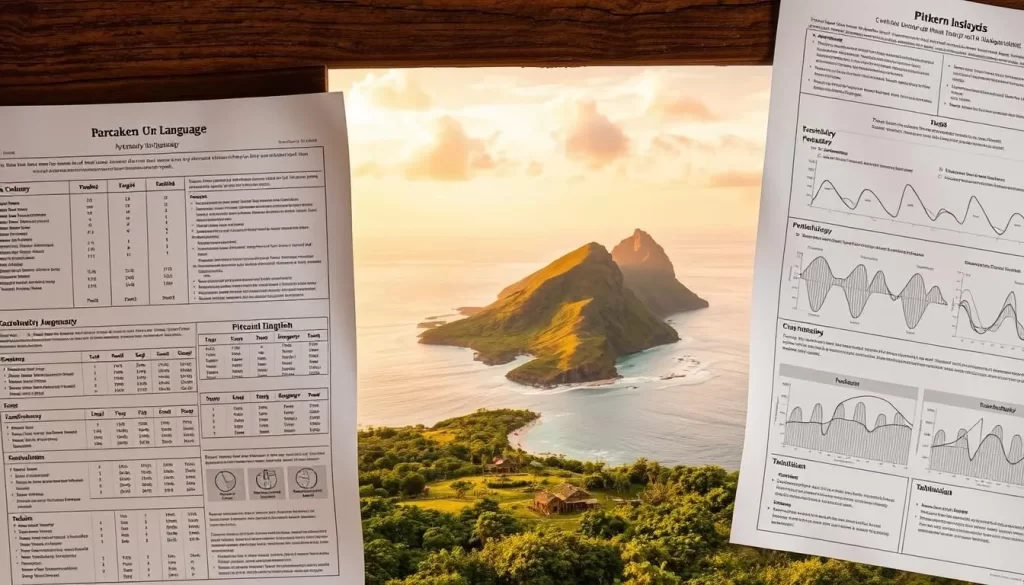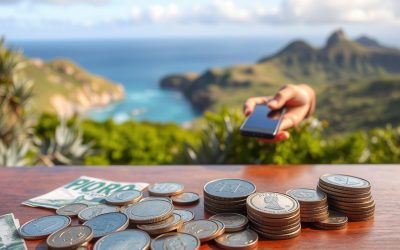✓ Accommodations✓ Flights✓ Rental Cars
Welcome to a place where culture and history intertwine through language. Pitcairn Island is not just a remote destination; it’s a living testament to a unique linguistic heritage. Here, you’ll discover how Pitkern, a blend of 18th-century English and Tahitian, shapes the island’s identity.
With a population of just 35 inhabitants, this small community takes pride in preserving its traditions. English and Pitkern are the two primary languages used daily, reflecting the island’s dual cultural roots. This blend of influences creates a fascinating linguistic landscape that’s unlike anywhere else.
Explore how the Pitcairn Islands have become a symbol of resilience and cultural preservation. Whether you’re a history enthusiast or a curious traveler, this introduction sets the stage for a deeper dive into the island’s rich heritage.
Introduction to Pitcairn Languages
The story of Pitcairn’s languages is deeply rooted in its fascinating past. This remote island’s linguistic heritage reflects a blend of Polynesian and European influences, creating a unique cultural identity.
Historical Context of the Pitcairn Islands
Early Polynesian settlers laid the foundation for the island’s culture. Later, European arrivals, including the famous mutineers of the HMS Bounty, brought their own traditions. This mix of cultures shaped the languages spoken today.
Understanding this history helps you appreciate how the island’s communication evolved. The blending of English and Tahitian elements is a direct result of these events.
Cultural Relevance in a Remote Community
In such a small community, language plays a vital role in preserving identity. With only 35 inhabitants, every word carries weight. The islanders take pride in their linguistic heritage, ensuring it remains alive.
Language here is more than just communication; it’s a bridge to the past. Stories, traditions, and values are passed down through generations, keeping the community connected.
This unique blend of influences makes Pitcairn’s linguistic landscape truly one-of-a-kind. It’s a testament to the resilience and adaptability of its people.
Origins of the Pitkern Language
The roots of Pitkern trace back to a dramatic chapter in maritime history. This unique language emerged from the blending of English and Tahitian elements, shaped by the events surrounding the HMS Bounty mutiny.

Eighteenth-Century Influences
In the late 1700s, the mutineers of the HMS Bounty settled on the island. They brought with them their native English dialects, which mixed with the Tahitian spoken by the Polynesian women who accompanied them.
This fusion created a new way of communication. Over time, the language evolved, retaining traces of its eighteenth-century origins.
The Blend of English and Tahitian Elements
Pitkern is a fascinating mix of two distinct linguistic traditions. While many Tahitian words have become nearly unrecognizable, the influence of both languages is still evident.
Here are some key features of this blend:
- Maritime terms from the ship and sailing life are prominent.
- The structure reflects English grammar but with unique twists.
- Certain phrases and idioms draw directly from Tahitian culture.
This linguistic blend is a testament to the resilience and adaptability of the island’s early settlers. It’s a living reminder of their shared history.
Pitcairn: Official and widely spoken languages
Language plays a pivotal role in shaping the identity of small communities. On Pitcairn Island, this is evident in the coexistence of Pitkern and English, both holding official status.
Language Status on Pitcairn Islands
Pitkern, a unique blend of 18th-century English and Tahitian, is recognized as an official language alongside English. This dual status reflects the island’s cultural and administrative priorities.
With a population of around 50, maintaining two languages is both a challenge and a point of pride. The small territory ensures that every word carries significant weight in daily life.
The Dual Role of Pitkern and English
Pitkern is deeply rooted in the island’s history, while English serves as the primary language for governance and education. This duality ensures that both traditions and modern needs are met.
Here’s how these languages impact daily life:
| Language | Role |
|---|---|
| Pitkern | Cultural preservation and informal communication |
| English | Administrative tasks and formal education |
The balance between these languages highlights the island’s resilience and adaptability. It’s a testament to how small communities can preserve their heritage while embracing modernity.
Linguistic Diversity in Pitcairn’s Community
Life on this island is deeply connected to its linguistic heritage. With a population of just 35 residents, every word spoken carries meaning and history. The blend of Pitkern and English creates a unique communication style that reflects the island’s dual cultural roots.

Everyday Communication and Social Life
For residents, language is more than just a tool for conversation. It’s a way to preserve traditions and strengthen community bonds. Pitkern, with its mix of English and Tahitian elements, is often used in informal settings, while English serves formal purposes.
This duality ensures that both the past and present are honored. For example, during local gatherings, you’ll hear stories passed down through generations, often in Pitkern. These moments highlight the island’s vibrant cultural life.
Modern influences have also shaped communication. Younger residents often blend traditional phrases with contemporary expressions. This mix keeps the language dynamic and relevant, ensuring it remains a vital part of daily life.
Preserving this linguistic heritage is a priority for the community. It’s not just about words; it’s about maintaining a connection to their shared history. For residents, language is a cornerstone of their identity and a source of pride.
The Evolution of Pitkern Vocabulary and Grammar
The evolution of Pitkern showcases a fascinating blend of linguistic creativity and historical adaptation. Over time, this unique language has developed distinct vocabulary and grammatical structures, setting it apart from other forms of English.
One of the most intriguing aspects is how names and expressions have evolved. Early settlers faced linguistic challenges, leading to the creation of new words and phrases. These adaptations reflect the blend of cultures and historical influences that shaped Pitkern.
Unique Expressions and Idioms
Pitkern is rich with unique expressions and idioms that highlight its cultural roots. For example, certain phrases draw directly from Tahitian traditions, while others reflect the maritime life of the early settlers.
These expressions often serve as a bridge between the past and present. They are not just words but carry stories and values passed down through generations.
Pronunciation and Syntax Developments
Pronunciation in Pitkern has also undergone significant changes. Early attempts to teach English to Tahitians led to grammatical breakdowns and sound elisions, creating a distinct phonetic system.
Syntax in Pitkern follows a unique pattern, blending English grammar with Tahitian influences. This type of structure makes the language both familiar and distinct to its speakers.
Understanding these developments helps you appreciate how dynamic and resilient Pitkern has become. It’s a living testament to the adaptability of its speakers and their rich heritage.
Influence of Mutineers and Tahitian Heritage
The legacy of the HMS Bounty mutiny continues to shape the unique linguistic identity of this remote island. The dramatic events of 1790 left a lasting imprint on the language, blending English and Tahitian elements into what is now known as Pitkern.

Both the male mutineers and the Tahitian women played pivotal roles in this linguistic evolution. Their interactions created a new way of communication, preserving elements of their respective cultures.
Legacy of HMS Bounty and Mutiny
The mutineers brought their English dialects, while the women introduced Tahitian words and phrases. Over time, these influences merged, forming a distinct language.
Here’s how these historical figures shaped Pitkern:
| Group | Contribution |
|---|---|
| Mutineers | Introduced English vocabulary and grammar |
| Tahitian Women | Added cultural expressions and phrases |
Each generation added layers of complexity to the language, ensuring its survival. This blend of influences is a testament to the resilience and adaptability of the island’s early settlers.
To learn more about Pitcairn Island’s rich history, explore the stories of its past. The island’s linguistic heritage is a celebration of cultural fusion and a reminder of its unique origins.
Resources and Tools for Learning Pitkern
Discovering Pitkern opens a window into a unique linguistic world. Whether you’re a language enthusiast or a researcher, having the right tools makes all the difference. From dictionaries to online platforms, there are plenty of resources to help you explore this fascinating language.
Dictionaries and Language Aids
One of the best ways to start learning Pitkern is through dictionaries. Scholars have compiled comprehensive guides that break down vocabulary and grammar. These aids are invaluable for understanding the blend of English and Tahitian elements.
For example, this source provides detailed insights into Pitkern’s structure and usage. It’s a must-have for anyone serious about mastering the language.
Online Resources and Academic References
The internet offers a wealth of materials for learning Pitkern. Websites and academic papers provide accessible ways to dive deeper into its linguistic nuances. These resources are particularly useful for comparing Pitkern with other dialects.
Norfolk Island, where Pitkern is also spoken, has contributed to the development of these tools. Exploring their resources can give you a broader perspective on the language’s regional spread.
| Resource Type | Description |
|---|---|
| Dictionaries | Comprehensive guides to vocabulary and grammar |
| Online Platforms | Websites and academic papers for deeper research |
| Regional Materials | Resources from Norfolk Island for broader context |
With these tools, you’ll have everything you need to explore Pitkern’s rich linguistic heritage. Start your journey today and uncover the stories behind this unique language.
Comparative Analysis: Pitkern vs. English and Tahitian
Exploring the linguistic ties between Pitkern, English, and Tahitian reveals a fascinating blend of history and culture. This comparison highlights how these languages influence each other, creating a unique linguistic identity for the island community.

Structural and Lexical Comparisons
Pitkern’s structure reflects a mix of English grammar and Tahitian elements. For example, while English follows a strict subject-verb-object order, Pitkern often adopts a more flexible syntax influenced by Tahitian.
Lexically, Pitkern borrows heavily from both languages. Words like “wata” (water) show Tahitian roots, while “ship” retains its English origin. This blend creates a vocabulary that is both familiar and distinct.
Language evolution here mirrors a child’s development. Each generation adapts and modifies words, ensuring the language remains relevant. For instance, the term “ye” (you) has evolved from English but is used more flexibly in Pitkern.
Specific lexical points reveal stark differences yet common roots. Words like “all yorlye” (all of you) showcase how Pitkern combines English and Tahitian into a single phrase. These adaptations highlight the island’s cultural fusion.
This analysis helps you appreciate the unique convergence of diverse language families. Pitkern stands as a testament to the island’s ability to adapt and preserve its heritage. For more insights into the island’s linguistic journey, explore Pitcairn’s rich history.
Modern Usage and Challenges of Preserving Pitkern
Preserving a unique language like Pitkern is no small task in today’s fast-paced world. With a small home community of just 35 residents, the challenges are significant. Limited resources and the influence of global languages make it difficult to keep this linguistic heritage alive.
Efforts to maintain Pitkern are akin to keeping a historic home intact for future generations. The community takes pride in its language, but the realities of modern life often clash with traditional practices. Balancing these two worlds is a constant struggle.
Community-Led Projects and Governmental Support
Despite the challenges, there are initiatives to sustain Pitkern. Community-led projects focus on teaching the language to younger generations. These efforts ensure that the linguistic heritage remains a vital part of daily life.
Governmental support also plays a crucial role. Funding for language preservation programs helps create resources like dictionaries and educational materials. These tools provide detailed information about Pitkern’s structure and usage.
Digital and Academic Resources
Modern technology offers new ways to preserve Pitkern. Online platforms and academic references provide accessible information for learners and researchers. These resources are essential for keeping the language relevant in a digital age.
For example, the Pitcairn Islands have embraced digital tools to document and share their linguistic heritage. This approach ensures that Pitkern continues to thrive, even as the world changes.
| Resource Type | Role in Preservation |
|---|---|
| Community Projects | Teaching and passing down Pitkern to younger generations |
| Governmental Support | Funding for educational materials and programs |
| Digital Tools | Online platforms for learning and research |
Preserving Pitkern is a testament to the resilience of its home community. By embracing both tradition and innovation, they ensure that this unique language remains a living part of their culture.
Conclusion
Pitkern is more than just a language; it’s a vibrant reflection of a small country’s cultural identity. This unique blend of English and Tahitian elements tells a story of resilience and adaptation. It’s a living testament to the enduring spirit of its people.
Exploring Pitkern offers a glimpse into a rich cultural narrative. The language’s evolution highlights the challenges and pride of preserving heritage. It’s a bridge connecting past, present, and future.
To dive deeper into this fascinating description, check out this resource. It provides valuable insights into the island’s history and linguistic journey. Understanding Pitkern is a step toward appreciating its global significance.
This description of Pitkern’s legacy invites you to connect with a unique cultural heritage. It’s a reminder of how language shapes identity and preserves history. Embrace the opportunity to explore this enduring legacy.
The above is subject to change.
Check back often to TRAVEL.COM for the latest travel tips and deals.




